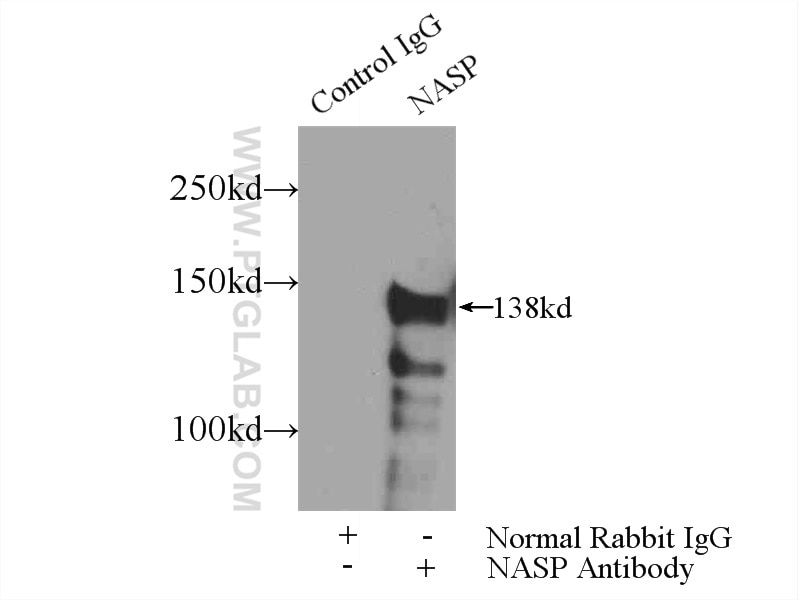- Featured Product
- KD/KO Validated
NASP Polyklonaler Antikörper
NASP Polyklonal Antikörper für WB, IHC, IF/ICC, IP, ELISA
Wirt / Isotyp
Kaninchen / IgG
Getestete Reaktivität
human, Maus, Ratte
Anwendung
WB, IHC, IF/ICC, IP, CoIP, ELISA
Konjugation
Unkonjugiert
Kat-Nr. : 11323-1-AP
Synonyme
Galerie der Validierungsdaten
Geprüfte Anwendungen
| Erfolgreiche Detektion in WB | Maushodengewebe |
| Erfolgreiche IP | Maushodengewebe |
| Erfolgreiche Detektion in IHC | humanes Hodengewebe, humanes Lymphomgewebe Hinweis: Antigendemaskierung mit TE-Puffer pH 9,0 empfohlen. (*) Wahlweise kann die Antigendemaskierung auch mit Citratpuffer pH 6,0 erfolgen. |
| Erfolgreiche Detektion in IF/ICC | MCF-7-Zellen |
Empfohlene Verdünnung
| Anwendung | Verdünnung |
|---|---|
| Western Blot (WB) | WB : 1:500-1:2400 |
| Immunpräzipitation (IP) | IP : 0.5-4.0 ug for 1.0-3.0 mg of total protein lysate |
| Immunhistochemie (IHC) | IHC : 1:20-1:200 |
| Immunfluoreszenz (IF)/ICC | IF/ICC : 1:10-1:100 |
| It is recommended that this reagent should be titrated in each testing system to obtain optimal results. | |
| Sample-dependent, check data in validation data gallery | |
Veröffentlichte Anwendungen
| KD/KO | See 1 publications below |
| WB | See 11 publications below |
| IHC | See 2 publications below |
| CoIP | See 1 publications below |
Produktinformation
11323-1-AP bindet in WB, IHC, IF/ICC, IP, CoIP, ELISA NASP und zeigt Reaktivität mit human, Maus, Ratten
| Getestete Reaktivität | human, Maus, Ratte |
| In Publikationen genannte Reaktivität | human, Maus, Ratte |
| Wirt / Isotyp | Kaninchen / IgG |
| Klonalität | Polyklonal |
| Typ | Antikörper |
| Immunogen | NASP fusion protein Ag1824 |
| Vollständiger Name | nuclear autoantigenic sperm protein (histone-binding) |
| Berechnetes Molekulargewicht | 788 aa, 85 kDa |
| Beobachtetes Molekulargewicht | 150 kDa, 70 kDa |
| GenBank-Zugangsnummer | BC010105 |
| Gene symbol | NASP |
| Gene ID (NCBI) | 4678 |
| Konjugation | Unkonjugiert |
| Form | Liquid |
| Reinigungsmethode | Antigen-Affinitätsreinigung |
| Lagerungspuffer | PBS mit 0.02% Natriumazid und 50% Glycerin pH 7.3. |
| Lagerungsbedingungen | Bei -20°C lagern. Nach dem Versand ein Jahr lang stabil Aliquotieren ist bei -20oC Lagerung nicht notwendig. 20ul Größen enthalten 0,1% BSA. |
Hintergrundinformationen
NASP (nuclear autoantigenic sperm protein) is associated with DNA replication, cell proliferation and cell cycle progression through functioning as a Histone H1 binding protein that mediates histone transport to the nucleus. NASP had two isoforms, tNASP (testis type) and sNASP (somatic type). The tNASP was mainly expressed in testis, a variety of malignant tumors, stem cells and embryonic tissues, while sNASP existed in all somatic mitosis cells. This antibody can recognize both isoforms.
Protokolle
| Produktspezifische Protokolle | |
|---|---|
| WB protocol for NASP antibody 11323-1-AP | Protokoll herunterladen |
| IHC protocol for NASP antibody 11323-1-AP | Protokoll herunterladen |
| IF protocol for NASP antibody 11323-1-AP | Protokoll herunterladen |
| IP protocol for NASP antibody 11323-1-AP | Protokoll herunterladen |
| Standard-Protokolle | |
|---|---|
| Klicken Sie hier, um unsere Standardprotokolle anzuzeigen |
Publikationen
| Species | Application | Title |
|---|---|---|
Genes Dev The death-associated protein DAXX is a novel histone chaperone involved in the replication-independent deposition of H3.3. | ||
Nat Struct Mol Biol The program for processing newly synthesized histones H3.1 and H4.
| ||
J Cell Sci Role of Template Activating Factor-I as a chaperone in linker histone dynamics. | ||
J Biol Chem MicroRNA-29a inhibited epididymal epithelial cell proliferation by targeting nuclear autoantigenic sperm protein (NASP). | ||
J Proteome Res Proteomic and Phosphoproteomic Analysis of Right Ventricular Hypertrophy in the Pulmonary Hypertension Rat Model | ||
Int J Nanomedicine Docetaxel-loaded solid lipid nanoparticles suppress breast cancer cells growth with reduced myelosuppression toxicity. |







